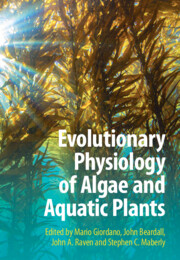Book contents
- Evolutionary Physiology of Algae and Aquatic Plants
- Evolutionary Physiology of Algae and Aquatic Plants
- Copyright page
- Contents
- Contributors
- Preface
- Acknowledgments
- 1 Environmental Changes Impacting on, and Caused by, the Evolution of Photosynthetic Organisms
- Part I Origins and Consequences of Early Photosynthetic Organisms
- Part II Physiology of Photosynthetic Autotrophs in Present-Day Environments
- Part III The Future
- 15 Aquatic Phototrophs and the Greenhouse Effect
- 16 Ultraviolet Radiation Effects under Climate Change
- 17 Variation in Nutrient Availability for Aquatic Phototrophs and Its Ecological Consequences
- 18 Algae: New Products and Applications
- Index
- References
16 - Ultraviolet Radiation Effects under Climate Change
from Part III - The Future
Published online by Cambridge University Press: 24 October 2024
- Evolutionary Physiology of Algae and Aquatic Plants
- Evolutionary Physiology of Algae and Aquatic Plants
- Copyright page
- Contents
- Contributors
- Preface
- Acknowledgments
- 1 Environmental Changes Impacting on, and Caused by, the Evolution of Photosynthetic Organisms
- Part I Origins and Consequences of Early Photosynthetic Organisms
- Part II Physiology of Photosynthetic Autotrophs in Present-Day Environments
- Part III The Future
- 15 Aquatic Phototrophs and the Greenhouse Effect
- 16 Ultraviolet Radiation Effects under Climate Change
- 17 Variation in Nutrient Availability for Aquatic Phototrophs and Its Ecological Consequences
- 18 Algae: New Products and Applications
- Index
- References
Summary
Solar radiation at the Earth’s surface contains ultraviolet (UV) radiation in the UVB (~295–315 nm) and UVA (315–400 nm) wavebands. Currently, atmospheric ozone removes shorter, more damaging UV radiation and reduces levels of UVB, but before the formation of the ozone layer, UV radiation levels would have been higher, while the recent ‘ozone hole’ increased UV radiation. UV radiation is strongly attenuated in water, but aquatic organisms can be damaged to extents that depend on the species and conditions. The targets of damage include proteins in the photosystems of photosynthesis, DNA and oxidative damage caused by the production of free radicals and reactive oxygen species. Defence against damage involves the production of new proteins, repair to the DNA and the production of antioxidants. UV stress interacts, positively and negatively, with other environmental changes such as rising temperature and CO2, ocean acidification and nutrient stress. Further research is needed to forecast responses to future environmental change.
Keywords
- Type
- Chapter
- Information
- Evolutionary Physiology of Algae and Aquatic Plants , pp. 315 - 340Publisher: Cambridge University PressPrint publication year: 2024

